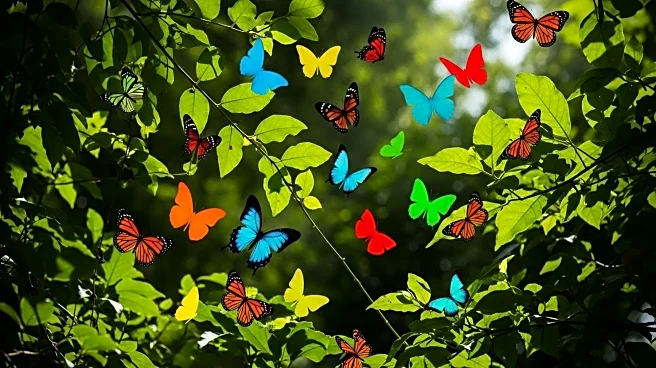What is the story about?
What's Happening?
Recent research highlights the impact of deforestation on butterfly populations, particularly in tropical forests. As native forests are replaced by monocultures like eucalyptus plantations, the vibrant colors of butterflies are diminishing. This change is attributed to the loss of diverse habitats that support a wide range of butterfly species. The study, conducted in Brazil, found that butterflies in plantations are predominantly brown, contrasting with the colorful species found in natural forests. The research underscores the broader ecological consequences of habitat loss, as color diversity in butterflies is linked to important ecological interactions.
Why It's Important?
The decline in butterfly color diversity is a significant indicator of broader ecological degradation. Butterflies are often used as a measure of biodiversity health, and their color changes reflect the simplification of ecosystems. This trend could lead to the loss of specialized species and disrupt ecological interactions that rely on color signals. The findings emphasize the need for conservation efforts to protect native habitats and prevent further deforestation. The study also suggests that restoring degraded forests can help recover butterfly color diversity, highlighting the potential for ecological restoration to mitigate biodiversity loss.
What's Next?
The research calls for urgent action to protect and restore native forests to preserve butterfly diversity. Conservationists may advocate for policies that limit deforestation and promote sustainable land use practices. Additionally, further studies could explore the impact of different types of plantations on butterfly populations and identify strategies to enhance biodiversity in managed landscapes. The findings may also influence public awareness and drive support for conservation initiatives aimed at preserving the ecological richness of tropical forests.
Beyond the Headlines
The study reveals a hidden dimension of how species respond to environmental changes, emphasizing the interconnectedness of ecological processes. The loss of color diversity in butterflies could signal broader ecological shifts, affecting other organisms and ecosystem functions. This research highlights the importance of maintaining complex habitats to support diverse ecological interactions and prevent the erosion of ecological functioning.
AI Generated Content
Do you find this article useful?
















